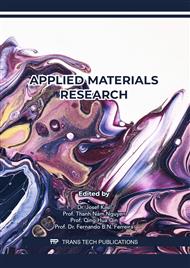[1]
Zhu BF (2013). Thermal stresses and temperature control of mass concrete. Butterworth-Heinemann, Oxford, UK.
Google Scholar
[2]
Mehta PK and Monteiro P (2006) Concrete—microstructure, properties, and materials (3rd ed.). McGraw-Hill, NY, USA.
Google Scholar
[3]
Ben-Bassat M, Nixon PJ and Hardcastlet J (1990) The effect of differences in the composition of Portland cement on the properties of hardened concrete. Magazine of Concrete Research, 42(151): 59-66.
DOI: 10.1680/macr.1990.42.151.59
Google Scholar
[4]
Dakhil FH, Al-Gahrani AS, Al-Saadoun SS and Bader MA (1990) Influence of cement composition on the corrosion of reinforcement and sulfate resistance of concrete. ACI Materials Journal, 87(2): 114-122.
DOI: 10.14359/1908
Google Scholar
[5]
Sezer GI, Çopuroğlu O and Ramyar K (2010) Microstructure of 2 and 28-day cured Portland limestone cement pastes. Indian Journal of Engineering and Materials Sciences, 17: 289-294.
Google Scholar
[6]
Altoubat S, Junaid MT, Leblouba M and Badran D (2017) Effectiveness of fly ash on the restrained shrinkage cracking resistance of self-compacting concrete. Cement and Concrete Composites, 79: 9-20.
DOI: 10.1016/j.cemconcomp.2017.01.010
Google Scholar
[7]
Khan I, Castel A and Gilbert RI (2017) Tensile creep and early-age concrete cracking due to restrained shrinkage. Construction and Building Materials, 149: 705-715.
DOI: 10.1016/j.conbuildmat.2017.05.081
Google Scholar
[8]
Shen D, Liu K, Ji Y, Shi H and Zhang J (2017) Early-age residual stress and stress relaxation of high-performance concrete containing fly ash. Magazine of Concrete Research, 70(14): 726-738.
DOI: 10.1680/jmacr.16.00216
Google Scholar
[9]
Xin J, Zhang G, Liu Y, Wang Z, Wu Z (2020) Evaluation of behavior and cracking potential of early-age cementitious systems using uniaxial restraint tests: A review. Construction and Building Materials,2020(231):117146.
DOI: 10.1016/j.conbuildmat.2019.117146
Google Scholar
[10]
Xin J, Zhang G, Liu Y, Wang Z, Yang N, Wang Y, Mou R, Qiao Y, Wang J, Wu Z (2020) Environmental impact and thermal cracking resistance of low heat cement (LHC) and moderate heat cement (MHC) concrete at early ages. Journal of Building Engineering,2020(32):101668.
DOI: 10.1016/j.jobe.2020.101668
Google Scholar
[11]
Xin J, Zhang G, Liu Y, Wang Z, Wu Z (2018). Effect of temperature history and restraint degree on cracking behavior of early-age concrete. Construction and Building Materials,2018(192):381-390.
DOI: 10.1016/j.conbuildmat.2018.10.066
Google Scholar
[12]
Weiss J (2002) Experimental determination of the time-zero (maturity-zero), in: A. Bentur (Ed.), Early Age Cracking in Cementitious Systems, Report of RILEM Committee TC 181-EAS, RILEM Publications Sarl, Bagneux, France, pp.195-206.
DOI: 10.1617/2912143632.019
Google Scholar
[13]
Cusson D and Hoogeveen T (2007) An experimental approach for the analysis of early-age behaviour of high-performance concrete structures under restrained shrinkage. Cement and Concrete Research, 37(2): 200-209.
DOI: 10.1016/j.cemconres.2006.11.005
Google Scholar
[14]
Atrushi DS (2003) Tensile and compressive creep of early age concrete: testing and modelling, PhD dissertation, Norwegian University of Science and Technology, Trondheim, Norway.
Google Scholar
[15]
Neville AM, Dilger WH and Brooks JJ (1983) Creep of plain and structural concrete. Construction Press, NY, USA.
Google Scholar
[16]
Tao Z and Weizu Q (2006) Tensile creep due to restraining stresses in high-strength concrete at early ages. Cement and Concrete Research, 36(3): 584-591.
DOI: 10.1016/j.cemconres.2005.11.017
Google Scholar
[17]
JY Li, XP Peng, JG Cao, et al. (2004) Research of high belite cement dam concrete with low-heat and high crack resistance. Journal of the Chinese Ceramic Society, 32(3): 364-370. (in Chinese).
Google Scholar


